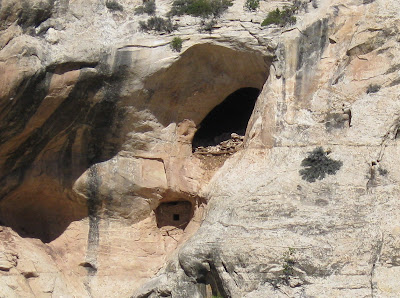The Dry Wash Trail is labeled as Road 5385 where it makes a junction with Forest Road 095 about 1.3 miles west of the Nizhoni Campground area in the Manti-La Sal National Forest. This area is reached from the Dry Wash Forest Access Road on the north side of Blanding in southeast Utah
The trail travels north along a rough forest road. In the distance there are some alcoves visible in the sandstone cliffs. I thought there might be ruins sites in this area, but I didn't know where they might be.
As the trail climbs, the alcoves are obscured by the rich forest and go out of sight and it is easy to walk past them. I stayed on what appeared to be the main trail for about 1.5 miles and then followed a cow trail for about 0.5 miles further, checking the sunlit side canyons for signs of ruins. The forest here is a mix of Ponderosa Pines and Douglas Firs, Aspens, Maples, Narrowleaf Cottonwoods and Gambel Oak.
On the return hike, after not seeing any ruins, I walked up an east leading side trail that is less than 10 minutes from the starting point that appeared to head for the alcoves that are visible. This trail climbs and passes below the alcoves and then arrives at a T junction of trails. Staying to the left there is a bench and interpretive sign. There aren't any trail markers to guide you to this spot, but if you arrive there is a place to sit and enjoy the view.
Up above is the Dry Wash Cave Ruins. The interpretive sign says that this is a food storage site, built in about 1250 AD. To the right, there is some intact stonework built around a frame of wood. To the left there is only a minor amount of stone remaining but many wooden poles that have fallen into a tangle. The interpretive sign says that this site was reached with the help of ladders and that visitors should not attempt to climb up.
The trail head elevation is about 7400 feet and the ruins sites are at about 8000 feet. The interpretive sign says that the Ancestral Pueblo People came this high into the mountains for the water supply, just as we do today. Past the ruins view area there is a pipe visible that is conducting water to the town of Blanding.
Returning to the T junction and continuing around the canyon shelf, there is another view point about 0.2 miles away that shows two more storage sites visible.
In the smaller site the stone work appears to be well preserved.
I followed this trail for another 0:10 minutes where there are views that include Mt. Linnaeus, the alcoves, and the canyon area north of the alcoves. From this point it took 0:30 minutes to return to the trail head. My total hike took 3:30 hours including 2:00 hours of being off the direct track to the ruins sites. I carried 2 liters of water on a 60 F degree mid October day. There were no other hikers in the area on the day I hiked.



